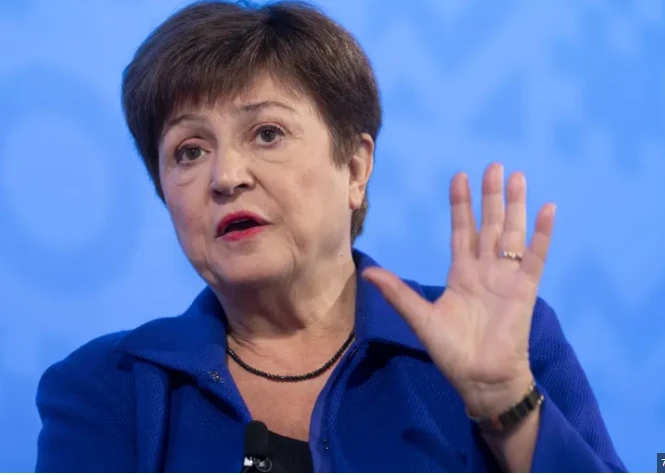IMF says Pakistan's growth to remain 3.2pc in 2024, unemployment at 7.5pc

Stay tuned with 24 News HD Android App

International Monetary Fund (IMF) announced on Tuesday that Pakistan’s economic is expected to remain 3.2 percent this year which will remain the same in 2025, reported 24NewsHD TV channel.
IMF predicts Pakistan's inflation to decrease and economic growth to increase. This year, the economic growth rate of Pakistan is expected to be 3.2 percent while Pakistan's GDP to grow by 2.4 percent in 2025.
According to the IMF, during 2023, GDP of Pakistan was negative 0.6 percent but this year inflation is likely to decrease to 9.5 percent. Last year, the rate of inflation in Pakistan was 23.4 percent. The unemployment rate in Pakistan is likely to be 7.5 percent this year while the previous year the unemployment rate in Pakistan was 8 percent. According to the IMF, the current account deficit of Pakistan is likely to be negative 0.9 percent this year. During 2023, country’s current account deficit was negative 0.2 percent.
Earlier, in its new World Economic Outlook (WEO) report, the IMF also estimates that global inflation will continue to ease, hitting 5.8 per cent this year, before falling to 4.3pc in 2025. “We are seeing inflation moving in the right direction without a major slowdown in economic growth or a global recession,” IMF chief economist Pierre-Olivier Gourinchas said ahead of the report’s publication.
“In our baseline analysis, in advanced economies [inflation] will be back at central bank targets in 2025,” he continued, adding it would take “a little bit longer” for emerging markets. The Fund’s WEO report noted that global growth is expected to trend to a lacklustre 3.1pc by 2029, and warned of growing risks to that metric. Beneath the relatively calm outlook for growth through 2025, “the picture is far from monolithic”, the Fund said, warning of “important sectoral and regional shifts” taking place over the past six months.
The WEO’s publication comes a day after the IMF and World Bank Annual Meetings got underway in Washington, bringing together finance ministers and central bankers from around the world for meetings on the health of the global economy.
The report finds that the United States has remained an engine of global growth — in sharp contrast with the euro area, where expansion remains slow. The world’s largest economy is now expected to grow by 2.8pc this year, down ever-so-slightly from the 2.9pc seen in 2023, but still a shade better than the Fund’s previous estimate in July.
It is then expected to ease somewhat to 2.2pc in 2025 — up 0.3 percentage points from July — as fiscal policy is “gradually tightened and a cooling labour market slows consumption”, the IMF said. “The US economy has been doing very well,” Gourinchas said, pointing to strong productivity growth and the positive effects of a surge in immigration on economic growth.
He added that the US is “very close” to achieving a soft landing — a rare feat in monetary policy, where inflation falls to within targets without spurring a severe recession. In Europe, growth is still trending higher, but remains low by historical standards, and is on track to be at an anemic 0.8pc this year, rising slightly to 1.2pc in 2025.
While France and Spain saw upgrades in their outlook for 2024, the IMF cut its projections for German growth by 0.2 percentage points this year, and by half a percentage point next year, citing its “persistent weakness in manufacturing”. There was some good news in the United Kingdom, where growth is projected to accelerate in both 2024 and 2025, “as falling inflation and interest rates stimulate domestic demand”.
Growth in Japan is expected to slow sharply to just 0.3pc this year, before accelerating to 1.1pc next year, “boosted by private consumption as real wage growth strengthens”, according to the IMF. The Fund expects the growth in economic output in China to continue to cool, easing from 5.2pc last year to 4.8pc this year, and then falling further to 4.5pc in 2025.
“Despite persisting weakness in the real estate sector and low consumer confidence, growth is projected to have slowed only marginally,” the IMF said, pointing to “better-than-expected” net exports from the world’s second-largest economy. The slowdown in India looks set to be more pronounced, with the IMF drawing in growth of 7pc this year, down from 8.2pc in 2023.
It is then set to slow even further to 6.5pc, as the “pent-up demand accumulated during the pandemic” runs out, the IMF said. The IMF expects growth in the Middle East and Central Asia to pick up slightly to 2.4pc this year, before jumping to 3.9pc in 2025 as the temporary effect of oil and shipping disruptions fade. In Sub-Saharan Africa, the IMF predicts that growth will remain unchanged at 3.6pc this year, rising to 4.2pc in 2025 as weather shocks abate and supply constraints ease.
